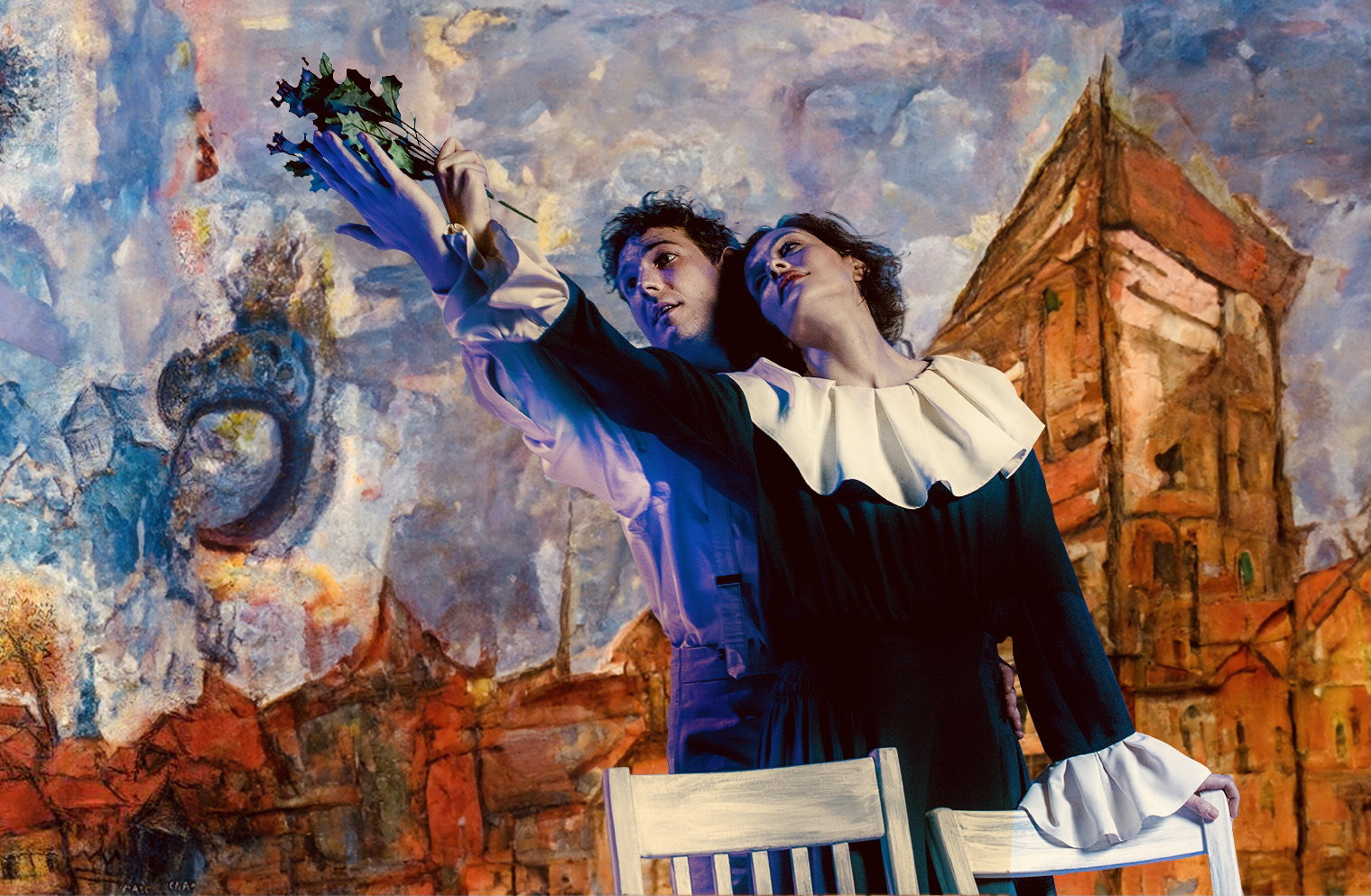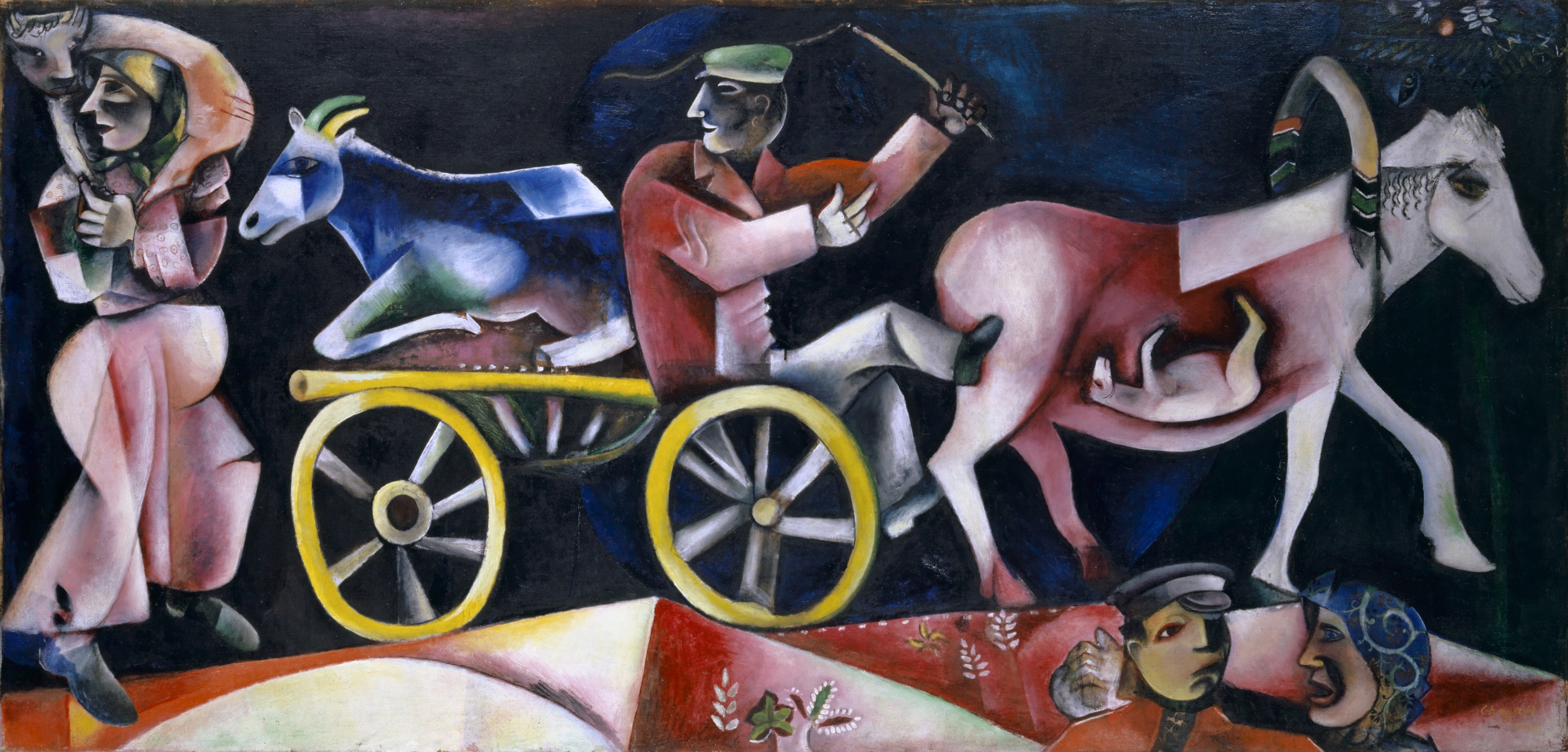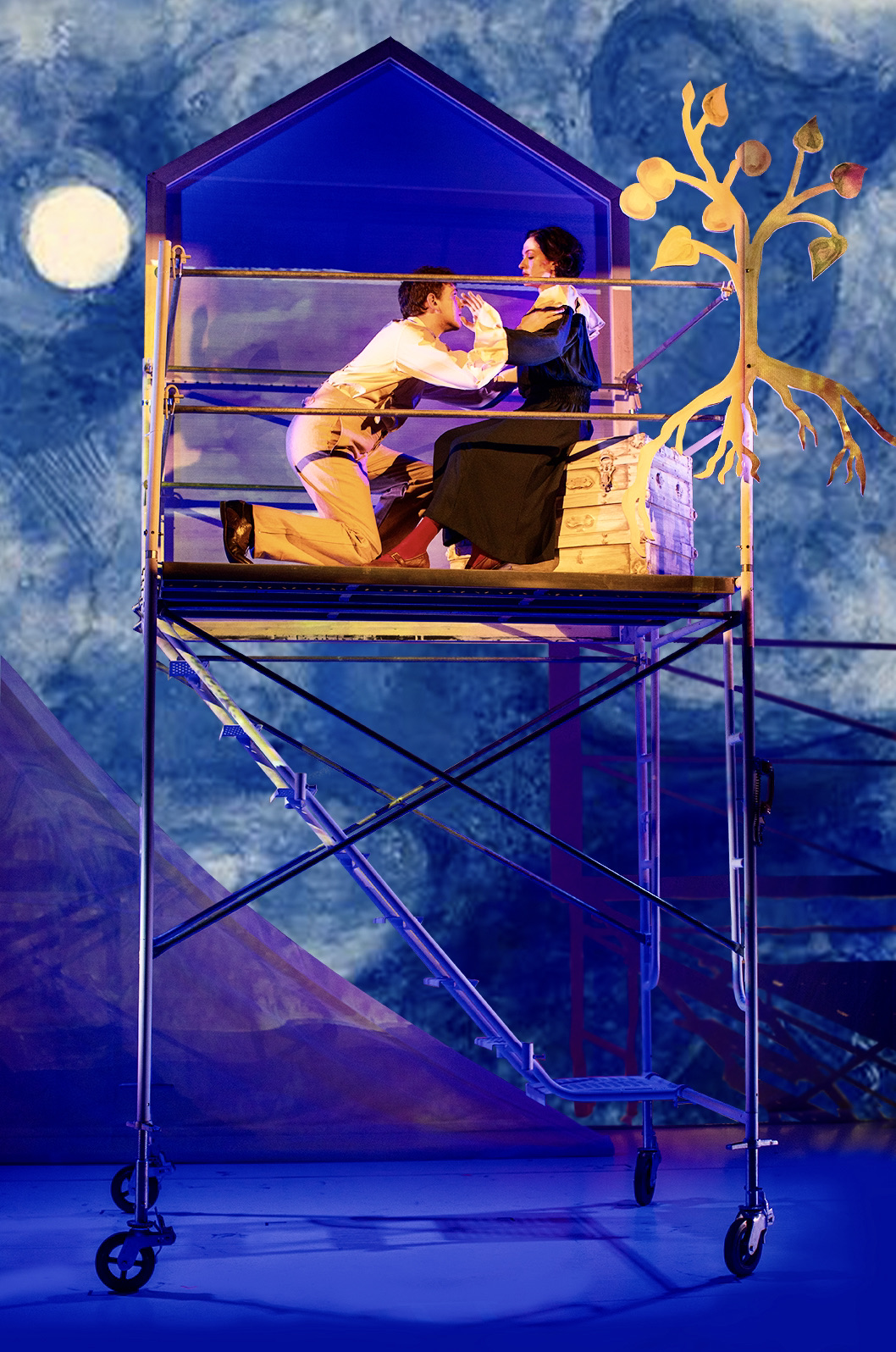Perfect Storm: Quantum’s ‘The Flying Lovers of Vitebsk’
- Like
- Digg
- Del
- Tumblr
- VKontakte
- Buffer
- Love This
- Odnoklassniki
- Meneame
- Blogger
- Amazon
- Yahoo Mail
- Gmail
- AOL
- Newsvine
- HackerNews
- Evernote
- MySpace
- Mail.ru
- Viadeo
- Line
- Comments
- Yummly
- SMS
- Viber
- Telegram
- Subscribe
- Skype
- Facebook Messenger
- Kakao
- LiveJournal
- Yammer
- Edgar
- Fintel
- Mix
- Instapaper
- Copy Link

Power couple Marc Chagall and Bella Rosenfeld Chagall fly high, wide, and sizzly in ‘The Flying Lovers of Vitebsk.’ The actors are Dan Mayhak and Zanny Laird. (photo: Jason Snyder)
Calling anything a must-see is an overstatement. If you haven’t seen Citizen Kane, don’t worry; you will be fine. But there is an urgency about live theater that makes it different from movies or TV. A powerful production of a play is a limited-time offer—an experience to be had before the run runs out, one that can’t ever be replicated by streaming on a screen. The Flying Lovers of Vitebsk, presented by Quantum Theatre in Pittsburgh through November 26, offers compelling reasons to come and see.
“Wow.” If you want a one-word review, that’s what this critic said to his seatmate at the end of the show on opening night. I only managed to say it in a hoarse whisper—barely able to make it audible, up close, over the volcanic applause for the actors taking their bows—because I was rocked by an avalanche of emotions, and otherwise speechless. The play has the impact of a perfect storm. Many themes, words, images, and theatrical touches come swirling together. For me, they resonated on multiple levels at once, setting off the inner avalanche. And I’d think that this multi-layered quality also gives the show a wide appeal. Several different kinds of audiences should find something in it that speaks to them.
Quite a trick for a deceptively simple-looking play. The Flying Lovers features just two actors, on a starkly equipped stage, accompanied by three musicians. (It’s a play with music, enhanced by songs and lyrical movement.) But there’s always a lot going on. The show delivers a story that is loaded.
Twists and Travels
British playwright Daniel Jamieson drew The Flying Lovers of Vitebsk from the true story of the lives of painter Marc Chagall (1887-1985) and his wife, the writer Bella Rosenfeld Chagall. Talk about a power couple: the two had passionate souls paired with keen minds, and they were madly in love. Actors Dan Mayhak as Marc and Zanny Laird as Bella absolutely sizzle together. They convey the electric bonds between them not only in eloquent language—”I talk to you so much that I keep tripping over your thoughts in my head,” Bella says—but also in shimmering glances, grimaces, and dance-like interaction. At one point, fully clothed, they simulate sex with such writhing conviction that I was almost embarrassed to watch. Life in the fast lane, indeed.
And they had to navigate a twisting, tricky fast lane through the minefields and upheavals of the early to mid-20th century. Europe during those years wasn’t the happiest place to be Jewish. The couple met and married in Vitebsk, now a city in Belarus, but at that time part of the Russian Empire’s Pale of Settlement—a fringe region where Jews were allowed to live, with what might be diplomatically described as only the occasional pogrom and harassment.
Long story short: the Chagalls moved around at a pace like that of today’s mobile professionals, often though not always with an eye to advancing Marc’s art career. Opportunities weren’t the only motivation. The First World War, the Russian Revolution, the rise of the Nazis in Germany, the Second World War, the Holocaust: these events kept uprooting and changing the playing field, perilously. Marc popped in and out of favor in Russia when the Bolshevik regime liberated him from anti-Semitic oppression, only to replace it with a more comprehensive secular-communist-conformist ecosystem of coercion. Years later, Paris in the early 1940s seemed like a good place for an artistic couple, despite the Nazi occupation—until Jews started disappearing, and the Chagalls luckily made a just-in-time exodus to America.
The Flying Lovers of Vitebsk packs vivid scenes of the couple’s journey into a whirlwind 90 minutes or so. And did the Chagalls keep rebounding jauntily and smiling bravely in unison all the way? Uh-uh. Some fierce frictions ensued. In one scene, Bella, having just labored through the birth of the couple’s only child, flames Marc for being out of the loop while absorbed in his precious art. Marc fires back that Bella lets everything be more important than her art and that’s why she’ll never be a serious writer. Which is the kind of thing that flares up IRL for many of us.

Marc’s 1912 painting ‘The Cattle Dealer’ shows the free-ranging uses of color and form that fueled his artistic ascent. In later works, he’d send human and animal figures airborne: hence the ‘Flying Lovers’ of the play’s title.
ART
And the art, the art! The making of art, especially visual art, with all that goes into it—from the sheer delight of finding ways to see the world anew, to the hard work and the bitter battles—is a theme throughout The Flying Lovers. Better yet, it’s meta-captured within theatrical art.
In the musical interludes where Marc and Bella sing to one another, they sing mostly in Yiddish. Unless you’re a Yiddish maven you won’t understand a word. But in addition to being authentic, this artistic choice works like gangbusters. It forces you to let go of the words and watch the couple inhabiting and expressing their song-ular feelings (which the actors do a great job of doing) … while at the same time you’re hearing, and in a sense also seeing, the soulful strains of Klezmer music from the ensemble on stage. We have a word for this shimmery transference of sensory experience. Aha, yes, thank you Google, it’s synesthesia. Whatever you call it, The Flying Lovers makes it fly. I think the Chagalls would approve.
What It Stacks Up To

A simple rolling scaffold frames a lot of the action. Here it stands as the couples’ walk-up apartment. (photo: Jason Snyder)
As mentioned previously, the show sings out on multiple levels, reaching and touching multiple kinds of interests that audience members might bring to the party. For anyone who is in a marriage or a committed relationship—or used to be, or wants to be—here’s a love story that should ring the chords of the heart.
For artists, and for anybody who cares about art, The Flying Lovers comes right down the groove.
For lovers of history, particularly but not exclusively Jewish history and/or European history in the 20th century, the show provides a new take on key events.
For people who are simply fans of good theater: definitely a short-list choice.
And for people who haven’t been to live theater since maybe their high school musical, this would be a fine show with which to get re-engaged.
Not saying it’s a must-see. Just saying.
Closing Credits and Ticket Info
The Flying Lovers of Vitebsk, by Daniel Jamieson with music by composer Ian Ross and others, is directed for Quantum Theatre by Gustavo Zajac. He’s also the choreographer. The show plays through November 26 in the theater at Rodef Shalom Congregation, 4905 Fifth Ave., Oakland. Visit the Quantum website for tickets and further information.
Along with actors Zanny Laird and Dan Mayhak, the performers in the music ensemble are violinist Cara Garofalo, oboe and horn player Lenny Young, and keyboard player Douglas Levine—the latter deserving multiple credits, since Levine has been in charge of musical direction, orchestration, and additional arrangements as well.
Director of production is J. Cody Spellman, with technical direction by James (Cubbie) McCrory. Scenic design is by Stephanie Mayer-Staley, lighting by C. Andrew Ostrowski, sound by Anthony Del Grosso, costumes by Grzegorz Labuda, and projection design by Peter Brucker. The stage manager is Cory F. Goddard, assisted by Nathan Walter.
The show is presented in concert with the Violins of Hope project, a Pittsburgh area-wide effort that includes an exhibit of violins played by Jewish musicians during the Holocaust, and numerous programs aimed at building diversity and understanding. Lastly but far from leastly:
The Flying Lovers is Quantum Theatre’s 100th production. Credit to founder and Artistic Director Karla Boos, who has led the company forward since 1990. She chose a mighty good piece for the 100 mark.
Mike Vargo, a Pittsburgh-based freelance writer, covers theater and other arts for Entertainment Central.
Share on Social Media
- Like
- Digg
- Del
- Tumblr
- VKontakte
- Buffer
- Love This
- Odnoklassniki
- Meneame
- Blogger
- Amazon
- Yahoo Mail
- Gmail
- AOL
- Newsvine
- HackerNews
- Evernote
- MySpace
- Mail.ru
- Viadeo
- Line
- Comments
- Yummly
- SMS
- Viber
- Telegram
- Subscribe
- Skype
- Facebook Messenger
- Kakao
- LiveJournal
- Yammer
- Edgar
- Fintel
- Mix
- Instapaper
- Copy Link
Follow Entertainment Central
Sign up for the EC Newsletter
Latest Stories







